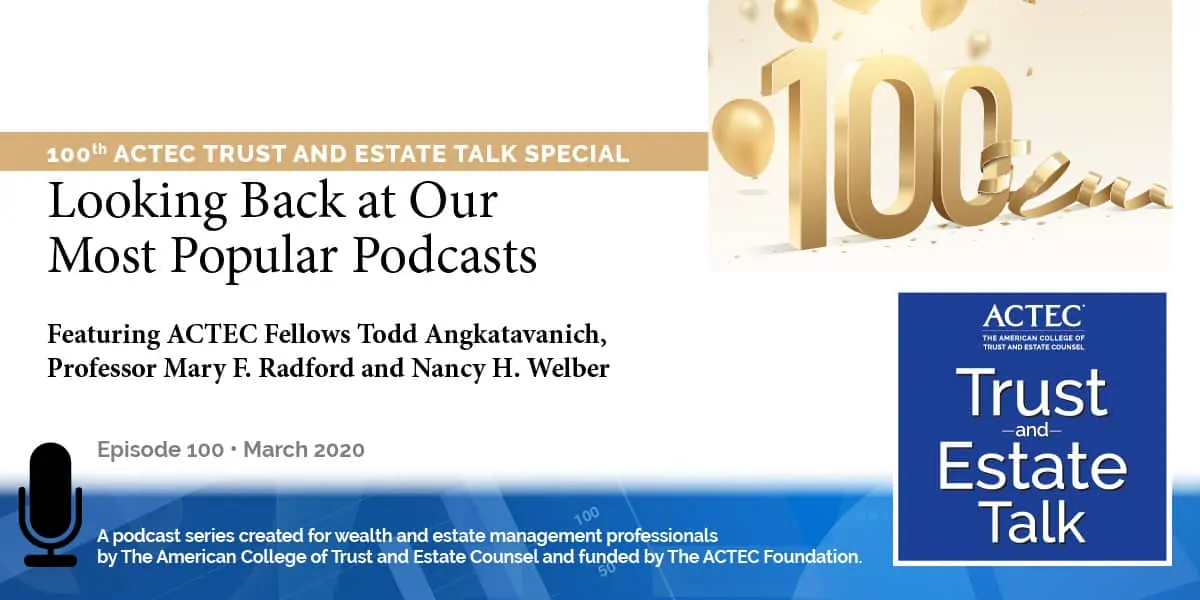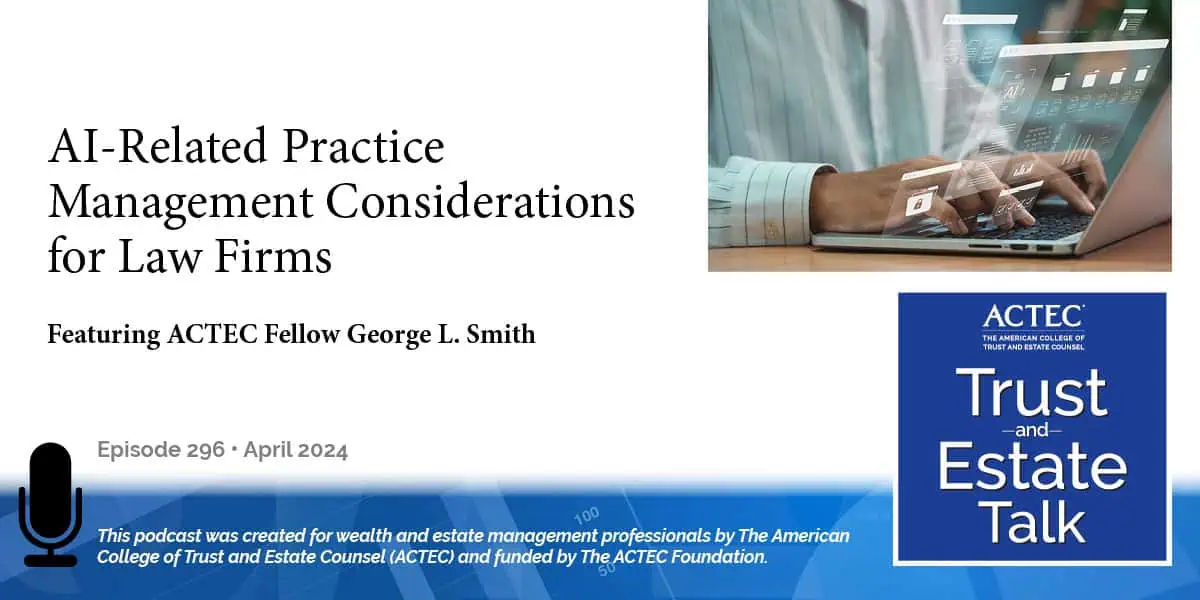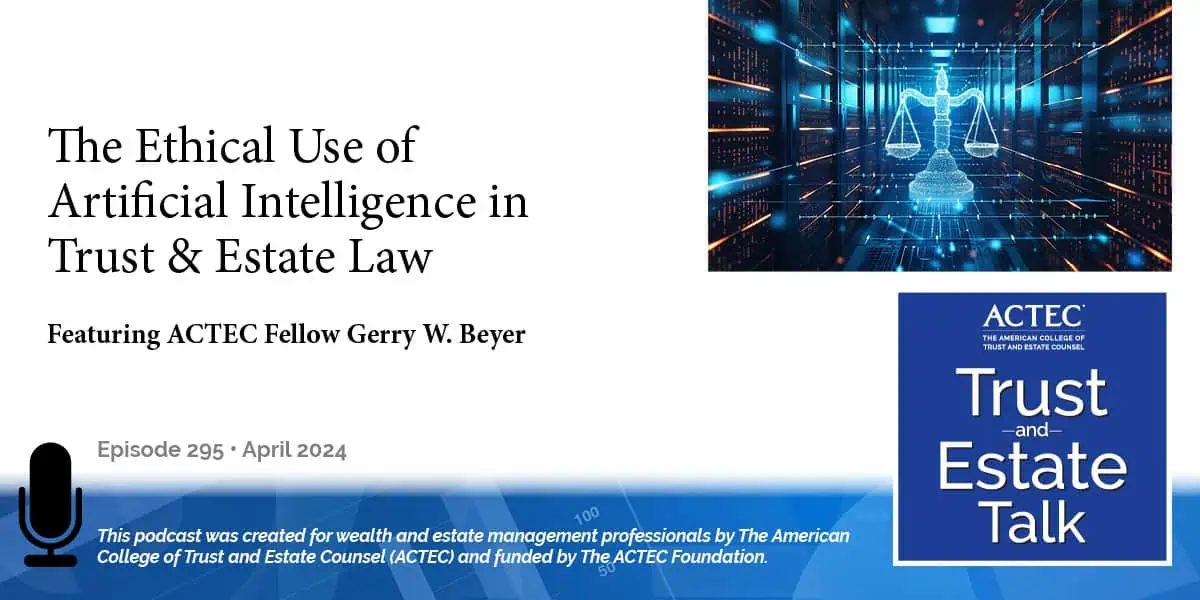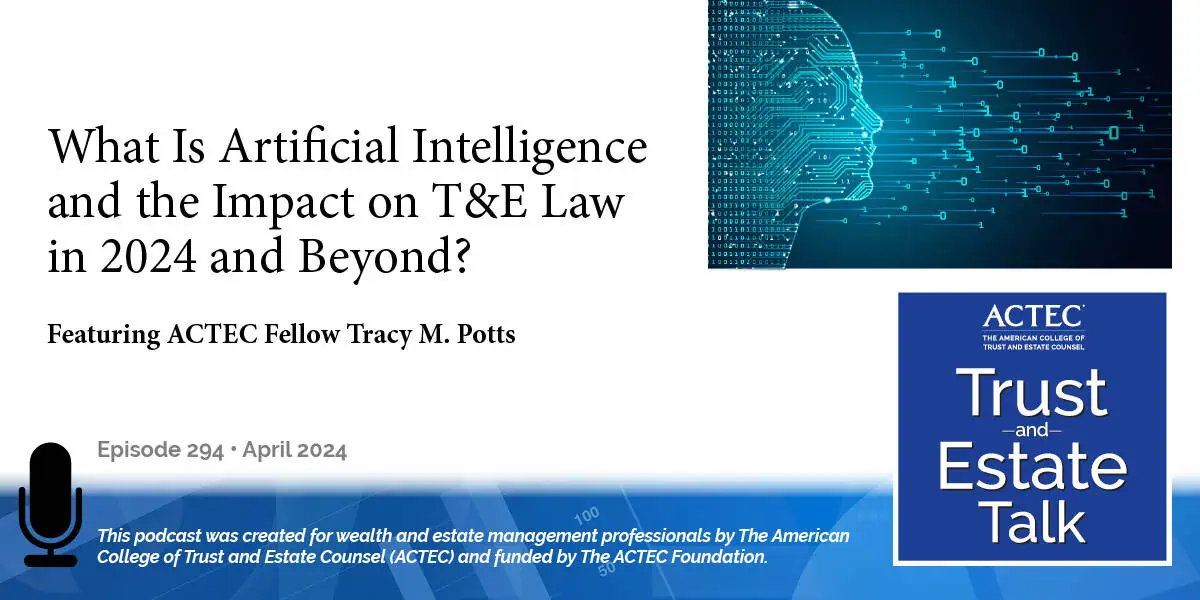Looking Back at Our Most Popular Podcasts | 100th Special

Highlights of a few of the most popular podcasts presented to date – a 100th ACTEC Trust and Estate Talk podcast special.
Transcript/Show Notes
This is Susan Snyder, ACTEC Fellow from Chicago. Today’s podcast marks our 100th podcast since the ACTEC Trust and Estate Talk series launched. To celebrate, we are bringing back highlights of the three most popular podcasts since we began. Joining me today for our 100th podcast special are ACTEC Fellows, Todd Angkatavanich of Hartford Connecticut, Professor Mary Radford of Atlanta, Georgia and Nancy Welber of Farmington Hills, Michigan. Welcome Mary, Nancy and Todd. Now Mary, your popular Trachtman lecture: Balancing Independence and Vulnerability of Older Adults: What if Granny Wants to Gamble? was one of our most popular podcasts. Can you give us some of those highlights?
Balancing Independence and Vulnerability of Older Adults
I’d be happy to. In “What if Granny Wants to Gamble?” I tried to paint a composite picture of an epidemic that’s sweeping across our country, and that epidemic is elder financial abuse. The abuse can take many forms from the numerous scams perpetrated by strangers, often strangers from other countries, to undue influence and fraud committed by an elder’s caregivers, friends, trusted advisors and even members of our own family.
The elderly are targeted not only because they are the wealthiest segment of our population, but also because they may be suffering from diminishing capacity or may be dependent upon the perpetrator for their care or may simply be too trusting of the people around them. The typical victim of elder financial abuse has been described this way: between the ages of 70 and 89, white, female, frail, cognitively impaired, isolated and lonely. So I asked, “Why are older women so often the target of these scamsters and fraudsters?”
First of all, older women outnumber older men in our society by about a two to one ratio by the age of 85. Two- thirds of the current sufferers of Alzheimer’s disease are women. Older women are also twice as likely to be alone, that is with a spouse or any close family members, than older men. One barrier to dealing effectively with elder financial abuse is that the victims are reluctant to report when it occurs. It’s estimated that one in 44 cases go unreported; and perhaps not surprisingly the closer the relationship is between the elder victim and the perpetrator, the less likely it is that the perpetrator will be prosecuted. Why is that? Sometimes it’s because the victims are simply too embarrassed to report or prosecute. Other times, the victims themselves are not absolutely certain that the abuse took place at all or that what took place was, in fact, abuse.
Other individuals – other people who have been victimized – might feel that at some level their children maybe are entitled to the money or property that they appropriated, perhaps due to some lingering guilt about not giving the child the appropriate amount of love and affection in that child’s youth.
Other victims simply don’t want to air their family’s dirty laundry or, God forbid, be responsible for sending a family member to jail. Finally, and perhaps saddest of all, many victims realistically comprehend that the remedy for the abuse may be worse than the harm. In other words, they fear – and it is a realistic fear – that by revealing their own victimization, this will cause other family members or maybe protective service workers to move them – the victims – to an institution or to proceed to impose a guardianship on them, which has the potential of depriving them of virtually all of their civil rights.
With what other crime in our country does reporting and prosecution carry such a tremendous risk to the victim of losing her own autonomy? It’s laudable that our society is beginning to focus so much attention on elder financial abuse, and in the lecture, I describe some of the governmental initiatives that are designed to curb this tide.
Unfortunately, however, our zealous impulse to protect older women and men may have the unfortunate effect of causing us to deprive some elders who don’t need our protection of their autonomy and control over their own lives. Our ages, stereotyping and generalization of people over a certain age may cause us to presume that their idiosyncrasies and eccentricities are signals that we need to step in and curb their freedom.
For example, every state has enacted laws that require that suspected elder financial abuse be reported to the states’ adult protective services agencies. These laws are modeled after the historically earlier child abuse protection laws. They infantilize and objectify the older individuals whom they are designed to protect. The child abuse reporting laws assumed that all children are incapable of protecting themselves. Unfortunately, the elder abuse reporting laws in many states make that same assumption about all people over a certain age. In other words, they designate elders, people over age 60 or 65, as per se people about whom reports should be made and on whom governmental protections should be imposed.
So in the lecture, I advocate for a more nuanced approach to dealing with elder financial abuse, one that recognizes that it’s equally important, if not fmoreso, to preserve the right of a financially secure high functioning granny who wants to gamble, to preserve her right to spend her money as she pleases. This is equally as important as protecting vulnerable, older women and men from those who are out to rob them of their life savings.
Thank you, Mary. Nancy, the SECURE Act podcast that you presented was our most popular to date. Can you give us an update on the SECURE Act?
The SECURE Act
Sure Susan, I would love to do that. So, there are a lot of things that changed in the SECURE Act, which at the time that we talked about it was only proposed. Now we have a new law. So, the first thing to know is 72 is the new 70 and a half. So, the required beginning date for someone who has to take distributions from their IRA or retirement plan is now April 1st of the year following age 72, or in some instances if you’re still working, the April 1st after the year that you retire.
There’s also something that’s very important to estate planners; the kiddie tax that was passed in 2017 as part of the Tax Cut and Jobs Act was repealed. Instead of using estate and trust income tax rates to tax those who are subject to the kiddie tax, it goes back to the parents’ marginal rates, which is an important improvement, especially for children who may get distributions from trusts. But the most important part of the SECURE Act that will affect estate planners is the elimination of the stretch IRA for most non-spouse beneficiaries. Instead of the stretch IRA, most non-spouse beneficiaries will now use a 10-year rule.
The 10-year rule is similar to the 5-year rule for non-designated beneficiaries, so that the retirement account has to be liquidated by the end of the tenth year following the death of the account owner, but there are exceptions. So, there are eligible designated beneficiaries, a new category of designated beneficiaries. So, if you’re not an eligible designated beneficiary, the 10-year rule applies. But who are the eligible designated beneficiaries?
Well, all designated beneficiaries are individuals, but this special category is as follows: if you’re a spouse – the surviving spouse – then not to worry. Nothing is going to change for you, so you can still do rollovers or have distributions that are through an inherited IRA. Also, if an account owner names someone who is not more than ten years younger than they are, then that’s another person they can take using a stretch IRA. So in other words, you could name someone older but the person has to be not more than ten years younger. It’s usually a sibling.
Minor children of the account owner – I will talk about this shortly, but it’s limited to the children of the account owner. So anyone who has a grandchild or another minor, this does not apply to them. The 10-year rule would apply. And finally, disabled and chronically ill beneficiaries; that’s a special category.
So quickly, on minor children, once the child reaches the age of majority, then they no longer get the stretch. So before they become an adult, so to speak–they reach the age of majority–they can stretch using their own life expectancy but once they reach the age of majority, then the 10-year rule applies to them. But there’s a special exception, if they’re engaged in a specified course of education and they can extend that stretch until age 26. The problem is, we don’t know what the age of majority is under this law nor do we know what a specified course of education is. Further guidance will be needed. Once again, once they hit that age of majority, the 10-year rule will apply. So, the range of the stretch will either be somewhere between 28 and 36 years old.
Lastly, we have the disabled or chronically ill beneficiaries. The definitions are found in Section 72(m)(7) and 7702B (c)(2) respectively in the code. These are the disabled definition and that of chronically ill, rather than being a short-term definition as is typical under the definition of disability for social security purposes like SSDI or supplemental insurance, income must be long-term. Likewise, the chronically ill is based on long-term care contracts, which usually are recertified every 12 months. Well, that’s not going to be the case here. Again, it has to be long-term. For all eligible designated beneficiaries, the status as an eligible designated beneficiary must be present at the date of the account owner’s death. But there’s more to the disabled and chronically ill issue because there has to be a certification. We don’t know what that is under disabled; it’s not defined in the code or the regulations. But the chronically ill has a very specific definition and hopefully regulations will adapt that as a standard.
What else has changed? Well, there are Special Needs Trusts now that are very different from what existed in the current regulations, governing Trusts; and I don’t have time to talk about that now but I will be doing a podcast on disabled and chronically ill. So catch it there (The Latest News on the SECURE Act – April 21, 2020). Also, trust generally, we don’t think that the regulations will change all that much but instead of using life expectancy, a regular designated beneficiary under a see-through trust will use the 10-year rule, generally speaking, and an eligible designated beneficiary may need to use a conduit trust unless they’re disabled or chronically ill.
In short, we have a lot of unanswered questions and until we get more guidance, stay tuned for further developments and draft carefully.
Thanks, Nancy. And, we will be doing a series of podcasts with more details about the SECURE Act, so look forward to that (April 14 – May 12, 2020). So, my last guest on our special podcast is Todd who is going to be speaking about some hot topics. What are some planning opportunities that attorneys can use with their clients right now?
Estate Planning – Hot Topics of 2020
Well, thanks a lot. So there are some interesting ideas that we can think about, which I think are particularly relevant now in 2020; as we get further and further into the election season, I think now is probably a good time for people to be thinking about taking advantage of some of the planning opportunities that exist under the current state of the law. As we all know, we have an increased exemption for gift tax as well as estate tax purposes of 11.58 million dollars, that under current law is going to expire at the end of 2025.
However, we don’t know what that’s going to look like, let’s say, if there’s a different administration in office. The Bernie Sanders proposal would reduce down the gift tax exemption to one million dollars. Not sure under, let’s say a Biden proposal, exactly what that would be. But I think it’s safe to say that we should at least be thinking about taking advantage of the current state of the law, sort of a presented window of opportunity for certain planning ideas.
Now the one thing I think we’ve all sort of witnessed over the past couple years since the change is that, you know, with an eleven and a half or 11.58 million dollar exemption per person – so about 23 million between mom and dad – that’s an enormous amount of money. And so, there’s been a natural hesitation by people to say, well we’re going to take advantage of that right now and make gifts to the next generation, perhaps into trust because there’s a natural feeling of, well we don’t want to spoil the kids. And that’s certainly understandable. But what I would say is, I think as we think about planning going forward, there are a lot of ways that you can think about using the current exemption as a way to create a multigenerational structure with some governance provisions in place to ensure that you are sort of creating a very sort of organized structure that’s not going to spoil the kids. This can be used in the current environment to fortify various different planning structures that are in place. So for instance, pretty simply looking at the current state of affairs, maybe there are loans that have been done by the parents over the years, and looking at maybe forgiving those loans or making cash gifts in order to fund them off or pay them off. Because I think with loans, a lot of times maybe people might not have the best history of payment and compliance and that can lead to maybe an argument by the IRS that those were not real loans from inception but rather were gifts. So if you can use those to pay off, use the exemption to pay off those loans and sort of fortify your transaction, that’s a very good idea.
I think the other thing is that, as we’re getting into the 2020 planning, you know, we all witnessed the rush at the end of 2012 with the planning. And I think we’ve learned from that, that if we can take our time and be deliberate with our clients now to start the discussion and get structures in place so that they’re ready to maybe pull the trigger towards the end of the year, that could be an advantageous thing.
The other thing is we’re all aware of the sort of pressure that clients have been feeling with respect to family limited partnerships under the Powell case and the Cahill case; and while there are a number of different, you know, ideas that you can think about to evaluate your partnership and maybe clean them up and fortify them, one of the ideas might be to simply make gifts of remaining limited partnership interests the way that the parents continue to own and use that as a way to absorb the gift tax exemption.
The other thing is with this very large gift tax exemption that we have right now, there is more flexibility to make gifts of hard to value assets with so-called cushion gifts, so that if we’re making gifts and we’re not sure what the value is going to be, maybe if we make a gift of what we think is seven million dollars but if the value gets increased on a gift tax audit, there’s still three and a half million dollars or so of cushion or four and a half million dollars or so of cushion that we can use to absorb those additional gifts from a revaluation.
Aside from that, some other interesting things to think about or what I like to call so called “up-gen gifting” or “down-gen gifting.” And the basic notion is, well, we’ve got this increased exemption and maybe you have, let’s say, the first generation or the second generation that have been enormously successful but maybe their parents have modest wealth of, you know, couple 100,000 dollars or a million dollars or something like that, there might be opportunities to try to do structures to get assets up to the parents’ generation so that the parents can use those assets to absorb their own estate or gift tax exemptions. Possibly even get a basis step up.
Now, how do you do that? Well, you could certainly use some of your gift tax exemption to get assets up to your parents but maybe a more efficient way to do it is to think about maybe doing zeroed-out GRATs to get assets up to your parents as the remainder beneficiaries; and then they can have those assets in their estate, soak up their exemption, maybe get a basis step up. Maybe you could do a reverse-preferred partnership where you’re giving common growth interest up to your parents as opposed to your kids, and over time you can shift some significant growth over to your parents and they can create estate planning structures at their own generations.
Additional things – down generation planning, for instance. So similarly, let’s say we have a situation where we have a significant trust that maybe was a GRAT pour over, but it’s inherently a GST non-exempt trust. So that’s going to be cut by 40 percent when generation two passes on and the assets go to generation three. So, they’re sort of soft assets, if you will, from a multigenerational standpoint. Maybe distributions could be made out of that soft asset GST non-exempt trust to the G2 beneficiaries. They can use those exemptions – those funds – to absorb up their own exemptions by making additional gifts or new gifts into their own trust. Maybe they could be GST exempt and it’s for the benefit of multiple generations to come. So, those are just some interesting issues out there that we’re seeing right now.
Thanks Todd. Thanks for those great tips and thank you all for joining me for our 100th podcast special for the ACTEC Trust and Estate Talk.
This podcast was produced by The American College of Trust and Estate Counsel, ACTEC. Listeners, including professionals, should under no circumstances rely upon this information as a substitute for their own research or for obtaining specific legal or tax advice from their own counsel. The material in this podcast is for information purposes only and is not intended to and should not be treated as legal advice or tax advice. The views expressed are those of speakers as of the date noted and not necessarily those of ACTEC or any speaker’s employer or firm. The information, opinions, and recommendations presented in this Podcast are for general information only and any reliance on the information provided in this Podcast is done at your own risk. The entire contents and design of this Podcast, are the property of ACTEC, or used by ACTEC with permission, and are protected under U.S. and international copyright and trademark laws. Except as otherwise provided herein, users of this Podcast may save and use information contained in the Podcast only for personal or other non-commercial, educational purposes. No other use, including, without limitation, reproduction, retransmission or editing, of this Podcast may be made without the prior written permission of The American College of Trust and Estate Counsel.
If you have ideas for a future ACTEC Trust & Estate Talk topic, please contact us at ACTECpodcast@ACTEC.org.
© 2018 – 2024 The American College of Trust and Estate Counsel. All rights reserved.
Latest ACTEC Trust and Estate Talk Podcasts

AI-Related Practice Management Considerations for Law Firms
A discussion for law firms about how to incorporate AI in their practice management, including staff considerations, the “billable hour,” and more.

The Ethical Use of Artificial Intelligence in Trust & Estate Law
A law professor offers insights into the risks, rewards, duties and ethical considerations of lawyers using AI in their T&E practices.

What Is Artificial Intelligence and the Impact on T&E Law in 2024 and Beyond?
A primer on the types and uses of AI, then a deeper dive into the impact on trust and estate law from types to applications to ethical considerations.

